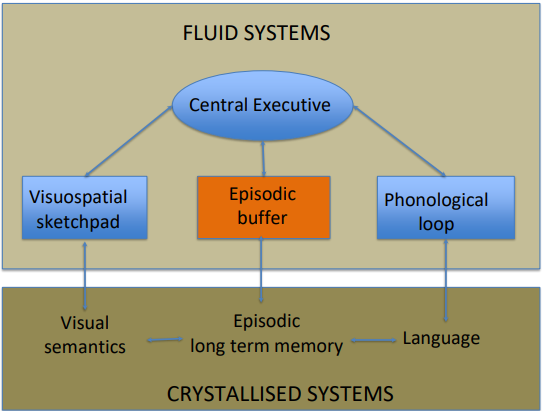Understanding working memory
Based on “Alan Baddeley´s model”
Timo Ahonen
Emeritus Professor
University of Jyväskylä, Finland
Orienting
• By reading and going through these slides You
will learn, step by step, the main features and
components of the Alan Baddeley’s “Model of
Working Memory (WM)”
FLUID SYSTEMS, fluid intelligence is:
• Complex human ability that allows us to adapt our
thinking to a new cognitive problem or situation. It is critical for wide variety of cognitive tasks and
for learning something new
CRYSTALLISED SYSTEMS, crystallized intelligence is:
• What we already know and can do, knowledge,
vocabulary, semantics, all the knowledge that we
have in our Long Term store or Memory (LTM).

Phonological loop
Is the storage system for speech-based
information (possibly acoustic information as
well)
• This system, it is not “clever”, it has no capacity
for controlling attention or decision –making
• It is merely a temporary storage for heard
information, particularly speech
• “It represents the storage system responsible for
“phonological short-term memory” – the ability to
remember small amounts of heard information
over short periods of time.
Two subcomponents of phonological loop
The phonological store:
• Is the area of the system in which speech material
is held for short limited periods of time (around 2
seconds) – “memory trace”, “trace decay” – rapid
fading of the trace
Articulatory rehearsal mechanism:
• we use it for recite the information in the
phonological store (e.g. repeating the phone
number) –re-entering the information back to the
phonological store.
Articulatory rehearsal mechanism is used also
for “phonological/verbal coding or recoding”
• In this process information presented in visual
form (printed words, printed letters/numbers,
pictures) can be converted into speech
• It can be done only if the visual information
has a verbal label (e.g. picture of a “house”,
labeled as “house”)
• Verbal coding helps us to remember
• Phonological/verbal coding of visual material
is carried out in the articulatory rehearsal
mechanism – “named” or “labelled”.

The visuospatial sketchpad
Is the component for holding visual and
spatial (and kinesthetic) information for short
periods of time, so that we can use it in
thinking, remembering and processing tasks.
• Component of the memory system for
supporting “visuospatial short-term memory”
Visuospatial sketchpad deal with three
types of information


The central executive
• Is the overall attention control of working
memory systems
• It has no capacity for storage – it is only
responsible for the control and allocation of
attention
• Central executive is “Focusing, dividing and
switching attention”
• The link between various working memory
components and long-term memory is through
“episodic buffer”.

The episodic buffer
The most recent addition to the working
memory model (Baddley, 2000)
• It is “multimodal temporary store” – not just
store information from one modality (e.g.
auditory, visual, kinaestethic) but information
from many different modalities
• It “binds” together information from different
sources within the working memory system.
• It joins multimodal information into a
coherent memory episode
• The capacity of the episodic buffer is not
clearly specified – the more the information
can be bound together in a coherent fashion,
the greater the capacity of the episodic buffer
(“chunking”).
“… a temporary storage system that is able to
combine information from the loops, the
sketchpad, long-term memory. Or indeed from
perceptual input, into a coherent” episode”
(Baddeley, 2007).
• Episodic buffer can act as a “backup store” to
supplement the phonological loop or
visuospatial sketchpad, as well as providing a
link to long-term memory e.g. we can
remember easier sentences and paragraphs
than single words or we remember better the
list of words than non-words.
Summary – Episodic buffer:
• (1) Allows long-term memory knowledge to be
utilized in the working memory system.
• (2) Offers extra storage mechanism to back up
other storage mechanisms.
• (3) blends together or “binds” information
from different sources/modalities into a
coherent memory experience.

Development of the Working Memory
Already the infants are showing WM in their actions.
At the age of 6 months the child can remember where
the person is hiding about 2 seconds and this ability
develops about 2 sec/month during the first year.
Baddley’s model can be used to describe WN from the
age 4-5 years onwards. There is individual variation
e.g. in span tasks (e.g. about 4-9 in Corsi task).
• All components of the WM are developing equally
about to 14-15 years of age The relationships between
the components are quite stable.